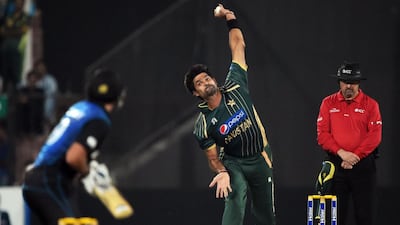Is cricket a gentler game since the death of Phil Hughes? The early evidence suggests, not so much.
On Friday night, at a frenzied, over-capacity Sharjah Cricket Stadium, Mohammed Irfan, the beanpole Pakistan fast bowler, sent down a short-pitched delivery to Dean Brownlie.
Unsurprisingly, given the height it had been propelled from, the 4.5-ounce leather missile reared up sharply upon bouncing and zeroed in on the opening batsman’s face.
Just in time, Brownlie snapped his neck muscles backwards, leaving enough space for the ball to career safely past his nose. The crowd whooped in delight at the spectacle.
An hour earlier, Adam Milne had been bowling like the wind for New Zealand. The 22-year-old tearaway quick induced a top edge from Shahid Afridi, who had just hit him for a couple of sixes.
When Daniel Vettori caught the ensuing skier, Milne turned to Afridi mid-pitch and, from point-blank range, barked a carnal roar which was part pleasure, part angry send-off.
Even Afridi, who is rarely anything but maniacally intense himself, raised a gloved hand and his bat, as if to say: “OK, son, maybe you should calm down.”
Maybe he should have done. Send-offs are not all they are cracked up to be. Just ask Varun Aaron, the India fast bowler.
During the Test match that was going on simultaneously in Adelaide, he had done similar to David Warner, the Australia opener.
It was more in relief, you would assume. The Indians probably felt as though they had been bowling to Warner all week, as he made dual centuries in the Test.
But Warner bit back furiously, once he was reprieved by the fact a review revealed it had been a no-ball.
No doubt he played out the whole Test in a haze of emotion, given the build-up, but he did not have the monopoly on that.
Elsewhere during the match in Adelaide, Virat Kohli had a pop at Steve Smith, despite the fact he was holding the responsible office of India captain for the occasion.
These were all people who had been putting out their bats together so recently, in tribute to Hughes. Clearly, they all realise their profession remains only a game. There are far more important things in life.
And yet as soon as the contest started, they were unable to help themselves. The thrill of the fight turned them into baying, angry young men again – as it was before.
Is the sport the poorer for it? Perhaps, and perhaps not.
Kohli was hit on the head by a bouncer from the most intimidating fast bowler of the day, Mitchell Johnson, at the start of his go with the bat.
Looked at through the prism of recent tragedy, it was a fearful moment for all concerned, not least the sport itself.
There has always been compassion for a stricken batsman in moments like that. It now carries with it catastrophic dread, though.
Yet Kohli was able to recover, scored a century, and was feted for it. Steve Waugh, the former Australia captain famed for the emphasis he placed on intimidating opponents, said Kohli had batted like an Australian. Presumably he could think of no higher praise.
The crowd had seen the spectacle, accepted the fleeting moment of fright, revelled in the spirit of combat, then appreciated the achievement of the protagonists.
The sport was unified in grief like never before, and hopefully never again, in the wake of Hughes’s death.
But no matter the tragedy, cricket – the gentleman’s game of long trousers, breaks for afternoon tea, and cucumber sandwiches – will not go gently. It can’t.
pradley@thenational.ae
Follow our sports coverage on Twitter @SprtNationalUAE


